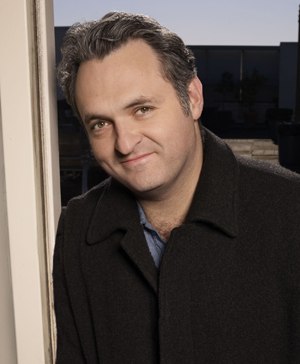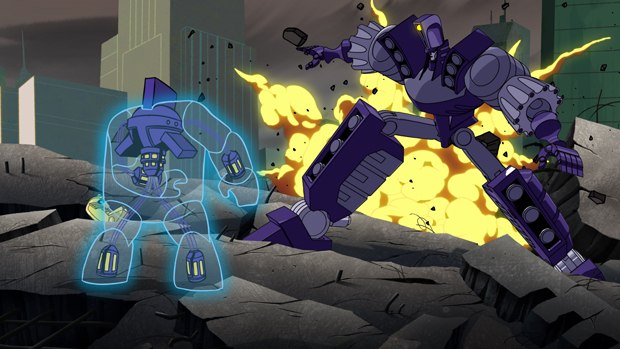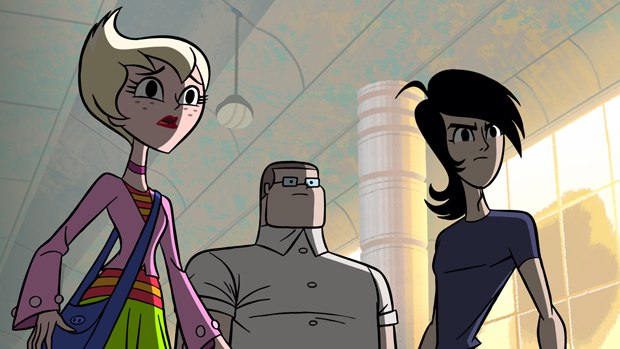Genndy Tartakovsky talks with Rick DeMott about his new series Sym-Bionic Titan, working in live-action and the Samurai Jack feature.

Genndy Tartakovsky is best known for creating two of the seminal shows in Cartoon Network's history, Dexter's Laboratory and Samurai Jack. He was born Moscow, Russia and at a young age moved from there to Italy then the United States. He got his first taste of animation at Columbia College Chicago, which led to him coming to California to study at CalArts. At CalArts, he created a short that spawned the Dexter's series. In addition to the shows he created, he was a director on other landmark Cartoon Network projects The Powerpuff Girls and Star Wars: Clone Wars.
After a flirtation with live-action, having developed the Dark Crystal sequel and storyboarded on Iron Man 2, he has now returned to the world of animation with the new series, Sym-Bionic Titan. There's just something about kids driving giant robots, isn't there? I had a chance to chat with Genndy Tartakovsky about just that and more.
Rick DeMott: What was the inspiration for the new show?
Genndy Tartakovsky: Speed Racer and Battle of the Planets. We wanted to do a version of those ourselves. I started messing around with this idea for a show about a robot, but he's disguised as a human in high school. So you put something with no emotion into the most highly intense emotional situation and see what comes out of it. So that was beginnings of it.
RD: What drew you to that mecha-style of anime?
GT: I think from my childhood always loving that idea of a kid in a giant robot. It's always been a theme we've played around with that's empowering. And it's super cool to see big giant robots fight. It's a lot of fun. It's always been something that's been with me. When we did Samurai Jack, I just loved samurais since I was a kid. It's just something that you fall in love with.
RD: What did you bring from your experience on the other series to this new project?
GT: Everything. I've been doing cartoons since I was 24 and now I'm 40. (laughs) So it's 16 years of doing TV shows. I think we brought everything to it. The humor. The action. The way we do the production. It's just the all out experience cumulating to the new show.
RD: I found the relationship between the main characters Lance and Ilana very interesting. I read somewhere else that an influence on the relationship was Hayao Miyazaki's Castle in the Sky. Can you comment more on that relationship?
GT: Yeah I think in Laputa it was one of my favorite things done in animation as far as the two characters' relationship where it was a boy and a girl, but there was so much camaraderie and a friendship there without going into the romance. There was something so heartfelt and sincere about the relationship that it was something that I always strived for. Sometimes it's more difficult to build a friendship than a love relationship. Love is easier in a way, because you can always go toward the attraction part. But to have friends be real friends and show them friendly and nice to each other is more complex and that's what inspired me from Castle in the Sky.
RD: The characters are aliens trying to blend into Sherman, Illinois, as an immigrant from Moscow to Chicago, did that influence that part of the story?
GT:
Yeah it does a lot. Myself and the head writer Darrick Bachman, we write most of the stories and it comes from our life experiences as far as the character stuff goes. I remember high school very much and so does Darrick, so we'll take something that's real, a real feeling that we experienced, and blend that in. The fitting in part, being an immigrant, is part of my life ever since we moved here, but I think it's beyond just immigrants and just fitting in with other people is something that we've been exploring.
RD: How difficult is it to balance between the character moments and robot battles?
GT: (laughs) It's extremely difficult. In the beginning we had a three-minute budgetary constraint on the action. Not only did we have to balance, we had this time constraint. But later that went away once we got rolling. But in the beginning we couldn't have a 10-minute action sequence because we just couldn't afford it.
But as far as the character stuff goes, we usually start with a character story. What's going to happen to those characters? What are they going to deal with? And then we start working in the action. As the series progressed, we'd have this amazing character story and then we'd finish it and we'd say, "Oh right, what action is in this?" And we'd have to figure out how to work in something to also make it exciting. That's the same time when I was getting paranoid. On Samurai Jack there would sometimes be 15 minutes of fighting. This show has a lot less than that. But we also wanted to develop a really strong character story, dramatic and comedic also. So balancing was hard. So some episodes are heavier toward the action and some are heavier toward the character stuff.
RD: What were some of the influences on the design style?
GT: The design started from the character side of it. After working on writing Astro Boy scripts six or seven years ago, I really got into Tezuka. After we did Dexter's and Samurai and Powerpuff I felt there were a lot of other shows that looked liked that also, so I wanted to break out of my own style and go in a different direction. So I started drawing this more Tezuka-ish inspired style. So it was a mix between Speed Racer and Fleischer and Tezuka. All mixed together. The robot stuff started out from Micronauts. It's basically Paul Rudish's designs. It's just Paul and he has every influence under the sun. But it's really his own taste that comes out. But it started with Micronauts, because I bought my kid a Micronauts toy and we were playing with it and I thought, "Man, this is such a cool thing." It's semi-translucent and I thought, "What if we did a robot that was semi-translucent."
RD: Is that translucent look done in CG with a 2D look?
GT: It's CG, but we've come up with a 2D rendering process so that the CG will fit into the 2D world.
RD: It blends in nicely. What programs are being used?
GT: It's Maya and After Effects. It's pretty basic there's nothing really fancy.
RD: Is the animation being done overseas?
GT: It's done with Rough Draft Studios with the same directors that worked on Dexter's and Samurai Jack and Clone Wars. I don't even see them as an overseas studio; I just see them as my directing partners. And so when the series got greenlit, we talked about doing this CG stuff and [they] built a CG unit, a really top-notched unit. We met together and started building stuff. It's great and it was all build for this show.
RD: Is there any new movement on the Samurai Jack feature?
GT: Because it's feature development it's a very long process. But just turned in another version of the outline and there has been some real positive feedback. We'll do a couple revisions and hopefully we can actually start storyboarding. It's on the cusp of going to full greenlight, but we're not quite there yet.
RD: Do you still have a desire to do live-action projects?
GT: I get an offer here and there, but nothing has come along like the Dark Crystal. The puppet thing was cool. That was the one that really fit perfectly. The other stuff is nothing that I really want to get into. It's funny; after working on Iron Man 2, it really made me love animation more. Because getting into that live-action world, it's pretty amazing and high profile, but I definitely know inside my gut that I'm an animator and I love animation and I love drawing. I really missed it when I wasn't doing that.
RD: How did the Iron Man 2 work come about?
GT: I went to Marvel to sell them on doing an animated thing and they started talking about some live-action stuff. And they said have you ever met with Jon Favreau, and I go no. So they gave him my number and I never thought anything would happen, but Jon called me and we got together for lunch and we started talking about stuff and he said for his first movie he really looked at Clone Wars and Samurai Jack for some of the fight stuff. For him it was the same tone that he was trying to get — some comedy that doesn't make fun of itself. And so he asked if I wanted to help on Iron Man 2 and I said sure. So myself and Brian Andrews started boarding for him and before you know we had [the] whole [Expo and Japanese garden] action sequence[s].
RD: What would you say is the key difference between boarding for animation and boarding for live-action?
GT: You have to think of it a little more realistically. Even though it's still CG and it's still animated, at the end of the day, it's still a cartoon in a way, but budget-wise it's a much more realistic thing. So if you do a crazy shot we had to sit down with an fx person and a camera person and really see if its practical or affordable. If this shot is going to cost $140,000 is it really worth it? It's far more shot per shot where in animation you can draw a crowd scene and it will take a few hours to do but it's not really going to kill the budget, but in live-action if you make something with too much complexity it's going to be a mess. You have to think more economically. I had to think of the real world. I was storyboarding this highway chase sequence and I actually went to the location and took a bunch of pictures and laid it out and kind of walked myself through it to see how I would actually shoot it. So it's a very different experience because before I would think of a picture and I would just draw it.
RD: Some other directors that started as storyboard artists have said that becoming a director made them a better storyboard artist. Do you think that is true?
GT: Of course. When you start directing you start thinking about the end product. You're always thinking of every single step. If you're a storyboard guy, you're just focusing on what you have to do. But as a director and a storyboard person, I know what it's going to take to make this look the way I want it to look at the end of day. I can't pass the buck so to speak. I'm along for the whole ride. So it makes you conscious of making things too complex. If I can't draw it, who's going to draw it? There's also the confidence that if I can storyboard it, I can produce it.
RD: Do you get to storyboard on Sym-Bionic or are you too busy working on other parts?
GT: No, no, there is a lot of me in there. Brian is the storyboard supervisor and we went over with everybody each board and really helped it along. This is the first show that we had ever done scripts. So before we always started with a first board, so we did a lot more writing in the storyboard process. Where here we have really good tight scripts and we sit down with a board person and we start going through it from the script. After, I realized the script was like a first board pass because it was written really visually. So it made the second board pass even better. So Brian and I would go over it and punch up the action. Really the more difficult part of it turned out to be the comedy. To do simple staging and acting that took a lot of effort. To communicate a cool joke is much harder than to communicate a cool action sequence.
RD: What drove the decision to do scripts and not go straight to boards?
GT: Part of it was network, because they wanted scripts. But for us it was a much more complex character show than we have ever done and we have a giant story arch that we're following. To leave it to each storyboard artist was too much reign. We had to control it a lot more. We had to lay out the arch and work one each episode. I think it made it easier on the board people and easier on me to make sure that everything is more episodic and all the mythology makes sense.
RD: Will some episodes be one-offs and other deal with a larger mythology run over the whole season?
GT: Yeah. There is a little bit of mythology in each one, but there are definitely some that are one-offs like you said. There are some that really play out the story of the characters and where they came from.
RD: I'm assuming that the mythology was something nailed from the beginning and you had to work it into the episodes.
GT: We wrote the whole thing out. This was something that we wanted to do. We wanted it to be a little more operatic. And we wanted a bigger story for the characters to deal with emotionally. So to really feel the pulse of that and control it, we definitely wrote it all out. So when we broke our first 20 down, we marked each episode and said here we need this and here we need that.
RD: Was it a challenge to work those elements into the different episodes or did it come organically from how you planned it out?
GT: It's part organic, but it's also a challenge. We go through a few episodes and realized that we haven't even introduced this whole big element yet. So you start to sprinkle a little bit here and there. As we progress we started to get better at it.
We were also afraid at how episodic we could be as far as the network goes. Because before on Jack. we were not allowed to be episodic at all. So we had to kind cheat our mythology into that. But on this if a character has a girlfriend, they'll have that girlfriend for four or five episodes until they break up. It's very cohesive and there is a lot of continuity.
RD: What do you think has made the network more willing to do something episodic?
GT: I think it's the state of television. Every single TV show that comes out now has continuity on it. Lost is the one that's more responsible for it. Even something like The Office has continuity. So when you have sitcoms doing it, it's kind of hard to say no. I think the face of television has changed.
RD: What's the biggest challenge of the new series?
GT:
The biggest challenge is that it's television. The budget, the time constraints are overwhelming. We bit off so much more than we can chew. It was huge aspirations to do a show like this for TV on this time and schedule that we had. The more drawn, volumetric designs through the action to the character stuff through the backgrounds. Every step of the way through this show everything was extremely difficult. A lot of people struggled through it more than they did in the past. Even as complex as something like Star Wars this show seemed so much harder. So that was the biggest challenge to get it to 70% or 80% of what we wanted. We said, "If we get 70% there, it will be great." We also involved lighting, which is extremely difficult in television. I have two jobs on this show. I had my morning job and my night job just to get it to the level we wanted it to be. Because this is the fifth show we've done together are expectations are much higher. We didn't want any B episodes. We wanted them all to be great.
RD: Is there anything you want people to know about the series?
GT:
I think the people who watch it will be surprised that no two episodes are the same. It's not like there is a formula where a monster shows up and they have to fight it. We have stories that are much more character based. Once we hit episode six, the story starts arching about the characters history and all the mythology and everything starts to really unravel. We were just warming up through the first five episodes. With episode six, it really kicks into gear. What we found is that each episode was better than the previous, which is really exciting.
Rick DeMott is the director of content for Animation World Network, VFXWorld and AWNtv. Additionally, he's the creator of the movie review site, Rick's Flicks Picks, which was named one of the 100 best movie blogs by The Daily Reviewer. He has written for TV series, such as Discovery Kids' Growing Up Creepie and Cartoon Network's Pet Alien, the animation history book Animation Art, and the humor, absurdist and surrealist website Unloosen. Previously, he held various production and management positions in the entertainment industry.












